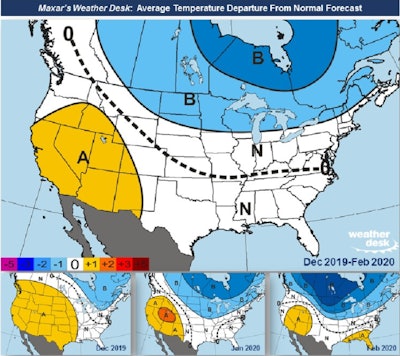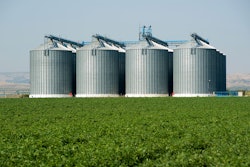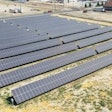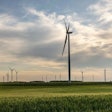
Given the high U.S. natural gas future prices last heating season, all eyes in the energy market will be on the upcoming season.
November 2018 started very cold, causing a noticeable increase in heating demand and a sharp uptick in prices, which exceeded $4.50 -- an amount greater than the past four years.
Maxar’s Weather Desk November 2019 forecast is warmer compared to November 2018, with near seasonal temperatures forecast for the U.S. East and above normal temperatures for the U.S. West.
For the heart of winter –- December through February -– Maxar’s Weather Desk forecast calls for above normal temperatures in the Southwest U.S. and below normal temperatures along the northern tier of the U.S.
条件与厄尔尼诺和拉尼娜现象有关major drivers of seasonal forecasts, especially for North America. The equatorial Pacific was in an El Niño state earlier this year but has since cooled to neutral levels and is expected to remain neutral through the winter season. Despite this, Maxar’s Weather Desk predicts that other factors may lead to colder temperatures.
“One of those factors is just west of the typical El Niño/La Niña monitoring area, near the International Dateline in the tropical Pacific, where waters have been record warm in recent months. This will be a region to watch for enhanced storminess and energy transfer toward the middle latitudes this winter. Historically, the region has been a cold influence for the eastern half of the U.S. in winter, especially in the second half of the season,” said Bradley Harvey, Maxar’s Lead Meteorologist.
Precipitation Outlook
A fast-flowing airstream will be responsible for directing above normal precipitation into the Northwest and northern Rockies this winter. Drier than normal conditions are forecast in the Southwest and Southern Plains. Precipitation is also forecast to be above normal for the Middle Atlantic into the Northeast, especially for January and February. These factors, combined with seasonal to below normal temperatures, would result in a higher than normal probability for snowstorms to impact the higher population centers of the United States during the heart of winter. For the skiing enthusiasts, the slopes in Colorado should have a decent season – especially the middle to the latter part of the winter with higher than normal snowfall expected.
Increased Demand for Gas
Maxar’s Weather Desk forecast from December to February totals 2,635 U.S. Gas Weighted Heating Degree Days (GWHDDs), a national index to monitor heating demand in the winter season. The forecast this season is near the 30-year normal but significantly higher than the 10-year normal. It is also colder than last winter.
Last winter, the temperature was volatile and difficult to predict. A colder-than-predicted November was followed by a warmer-than-predicted December and U.S. natural gas prices plummeted as a result of the warmth. In late-January 2019, when the short-lived Polar Vortex occurred in the Midwest, there was a spike in natural gas prices but it quickly decreased again as the rest of winter came in rather mild.
“Our confidence this year is lower than previous winter seasons given the mix of signals and lack of a clearer forcing mechanism driving the forecast,” said Harvey.
The pathway for colder-than-normal temperatures (which causes demand for gas) comes from the solar minimum (lack of sunspots), which has increasingly been associated with Arctic blocking events. The winter of 2009-2010 is an example whereby blocking resulted in a cold season across the Eastern Half of the U.S. and was the last time the solar minimum occurred. The warm risk to our forecast is similar to the past couple of winters with a stronger Southeast ridge response possibly blocking the onslaught of substantial Arctic air from reaching the U.S. East Coast. This is very similar to what occurred in February 2019.
According to Maxar’s Weather Desk, the end of the heating season may have lingering heating demand for the Northeast U.S. with March 2020 forecast to have temperatures average below normal. In recent years, because of the noticeable shift of colder temperatures developing later in the winter, the early parts of spring have resulted in colder than normal anomalies lingering.




















